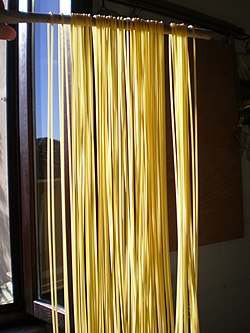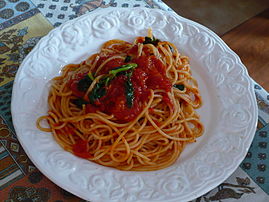Spaghetti
 Spaghetti hung to dry | |
| Type | Pasta |
|---|---|
| Place of origin | Italy |
| Main ingredients | Semolina or flour, water |
| Nutritional value per 1/2 cup (70 grams) | |||||||||||||||||||||||
|---|---|---|---|---|---|---|---|---|---|---|---|---|---|---|---|---|---|---|---|---|---|---|---|
| Energy | 460 kJ (110 kcal) | ||||||||||||||||||||||
22g | |||||||||||||||||||||||
| Sugars | 0g | ||||||||||||||||||||||
| Dietary fiber | 1g | ||||||||||||||||||||||
0.5g | |||||||||||||||||||||||
| Saturated | 0g | ||||||||||||||||||||||
| Trans | 0g | ||||||||||||||||||||||
4g | |||||||||||||||||||||||
| |||||||||||||||||||||||
Source: USDA [1] | |||||||||||||||||||||||
| †Percentages estimated using US recommendations for adults,[2] except for potassium, which is estimated based on expert recommendation from the National Academies.[3] | |||||||||||||||||||||||
Spaghetti (Italian pronunciation: [spaˈɡetti]) is a long, thin, cylindrical, solid pasta.[4] It is a staple food of traditional Italian cuisine. Like other pasta, spaghetti is made of milled wheat and water. Italian spaghetti is made from durum wheat semolina, but elsewhere it may be made with other kinds of flour.[5]
Originally spaghetti was notably long, but shorter lengths gained in popularity during the latter half of the 20th century and now spaghetti is most commonly available in 25–30 cm (10–12 in) lengths. A variety of pasta dishes are based on it.
Etymology
Spaghetti is the plural form of the Italian word spaghetto, which is a diminutive of spago, meaning "thin string" or "twine".[4]
History
Pasta in the West may have first been worked into long, thin forms in Sicily around the 12th century, as the Tabula Rogeriana of Muhammad al-Idrisi attested, reporting some traditions about the Sicilian kingdom.[6] In the 5th century AD, it was known that pasta could be cooked through boiling.[7] The popularity of spaghetti spread throughout Italy after the establishment of spaghetti factories in the 19th century, enabling the mass production of spaghetti for the Italian market.[8]
In the United States around the end of the 19th century, spaghetti was offered in restaurants as Spaghetti Italienne (which likely consisted of noodles cooked past al dente, and a mild tomato sauce flavored with easily found spices and vegetables such as cloves, bay leaves, and garlic) and it was not until decades later that it came to be commonly prepared with oregano or basil.[9][10][11]
Ingredients
Spaghetti is made from ground grain (flour) and water.[12] Whole-wheat and multigrain spaghetti are also available.[5]
Production
Fresh spaghetti

At its simplest, spaghetti can be formed using no more than a rolling pin and a knife. A home pasta machine simplifies the rolling, and makes the cutting more uniform. Fresh spaghetti would normally be cooked within hours of being formed. Commercial versions of 'fresh' spaghetti are manufactured.[13]
Dried spaghetti
The bulk of dried spaghetti is produced in factories using auger extruders. While essentially simple, the process requires attention to detail to ensure that the mixing and kneading of the ingredients produces a homogeneous mix, without air bubbles. The forming dies have to be water cooled to prevent spoiling of the pasta by overheating. Drying of the newly formed spaghetti has to be carefully controlled to prevent strands sticking together, and to leave it with sufficient moisture so that it is not too brittle. Packaging for protection and display has developed from paper wrapping to plastic bags and boxes.[14]
-
A hydraulic press with automatic spreader built by Consolidated Macaroni Machine Corporation, Brooklyn, New York. This machine was the first ever made to spread long cut alimentary paste products on to a drying stick for the automatic production of spaghetti.
-
An industrial dryer for spaghetti or other long goods pasta products. Built by Consolidated Macaroni Machine Corporation
-
Dried spaghetti
Preparation
Fresh or dry spaghetti is cooked in a large pot of salted, boiling water and then drained in a colander (Template:Lang-it).
In Italy, spaghetti is generally cooked al dente (Italian for "to the tooth"), fully cooked but still firm to the bite. It may also be cooked to a softer consistency.
Spaghettoni is a thicker spaghetti which takes more time to cook. Spaghettini is a thinner form which takes less time to cook. Capellini is a very thin form of spaghetti (it may be called "angel hair spaghetti" in English) which cooks very quickly.
Utensils used in spaghetti preparation include the spaghetti scoop and spaghetti tongs.
-
Spaghetti being placed into a pot of boiling water for cooking
-
A spaghetti scoop
-
Spaghetti tongs
Serving
Italian cuisine

An emblem of Italian cuisine, spaghetti is frequently served with tomato sauce, which may contain various herbs, (especially oregano and basil), olive oil, meat, or vegetables. Other spaghetti preparations include amatriciana or carbonara. Grated hard cheeses, such as Pecorino Romano, Parmesan and Grana Padano, are often sprinkled on top.
International cuisine
In some countries, spaghetti is sold in cans/tins with sauce.
In the United States, it is sometimes served with chili con carne. Unlike in Italy, abroad spaghetti is often served with Bolognese sauce.
Sapaketti phat khi mao (Spaghetti fried drunken noodle style) is a popular dish in Thai cuisine.[15]
Spaghetti dishes
- Spaghetti aglio e olio – ("spaghetti with garlic and oil" in Italian), a traditional Italian pasta dish coming from Naples.
- Spaghetti alla puttanesca – (literally "spaghetti whore-style" in Italian), a tangy, somewhat salty Italian pasta dish invented in the mid-20th century. The ingredients are typical of Southern Italian cuisine: tomatoes, olive oil, olives, capers and garlic.[16]
- Spaghetti alle vongole – Italian for "spaghetti with clams", it is very popular throughout Italy, especially its central regions, including Rome and further south in Campania (where it is part of traditional Neapolitan cuisine).
- Spaghetti with meatballs – an Italian-American dish that usually consists of spaghetti, tomato sauce and meatballs
- Spaghetti dishes
-
Spaghetti con pollo e funghi
-
Spaghetti pomodoro & basilico (tomato sauce and basil)
Market
Consumption
By 1955, annual consumption of spaghetti in Italy doubled from 14 kilograms (30.9 lb) per person before World War II to 28 kilograms (61.7 lb).[17] By that year, Italy produced 1,432,990 tons of spaghetti, of which 74,000 were exported, and had a production capacity of 3 million tons.[17]
Nutrition
Pasta provides carbohydrate, along with some protein, iron, dietary fiber, potassium and B vitamins.[18] Pasta prepared with whole wheat grain provides more dietary fiber[18] than that prepared with degermed flour.
Records
The world record for the largest bowl of spaghetti was set in March 2009 and reset in March 2010 when a Buca di Beppo restaurant in Garden Grove, California, filled a swimming pool with more than 13,780 pounds (6,251 kg) of pasta.[19]
In popular culture
Spaghetti Westerns have little to do with spaghetti other than using the name as a shorthand for Italian.
The BBC television program 'Panorama' featured a hoax program about the spaghetti harvest in Switzerland on April Fools' Day, 1957.[20]
See also
References
- ^ "Spaghetti, Enriched, Dry" (PDF). United States Department of Agriculture. October 2012. Retrieved 16 December 2014.
- ^ United States Food and Drug Administration (2024). "Daily Value on the Nutrition and Supplement Facts Labels". FDA. Archived from the original on 2024-03-27. Retrieved 2024-03-28.
- ^ National Academies of Sciences, Engineering, and Medicine; Health and Medicine Division; Food and Nutrition Board; Committee to Review the Dietary Reference Intakes for Sodium and Potassium (2019). Oria, Maria; Harrison, Meghan; Stallings, Virginia A. (eds.). Dietary Reference Intakes for Sodium and Potassium. The National Academies Collection: Reports funded by National Institutes of Health. Washington, DC: National Academies Press (US). ISBN 978-0-309-48834-1. PMID 30844154. Archived from the original on 2024-05-09. Retrieved 2024-06-21.
- ^ a b spaghetti. Dictionary.com. Dictionary.com Unabridged (v 1.1). Random House, Inc. (accessed: June 03, 2008).
- ^ a b "How to Make Spaghetti". Better Homes and Gardens. Retrieved on 22nd December 2014.
- ^ Kummer, Corby (1 July 1986). "Pasta". The Atlantic.
- ^ "Pasta is Not Originally from Italy". www.todayifoundout.com. Retrieved on 22nd December 2014.
- ^ Whiteman, Kate; Boggiano, Angela; Wright, Jeni (2007). The Italian kitchen bible. Hermes House. pp. 12–13. ISBN 978-1-84038-875-6.
{{cite book}}: Invalid|ref=harv(help) - ^ The Settlement Cook Book: Tested Recipes from the Settlement Cooking Classes, the Milwaukee Public School Kitchens, The School of Trades for Girls, and Experienced Housewives. Settlement Cook Book Company. 1921.
{{cite book}}: Invalid|ref=harv(help) - ^ Mazdaznan encyclopedia of dietetics and home cook book: cooked and uncooked foods, what to eat and how to eat it ... Mazdaznan associates of God. 1909.
{{cite book}}: Invalid|ref=harv(help) - ^ Levenstein, Harvey (2002). Counihan, Carole M. (ed.). Food in the USA: A Reader. Routledge. pp. 77–89. ISBN 0-415-93232-7.
- ^ Gisslen, Wayne; Griffin, Mary Ellen; Le Cordon Bleu (2006). Professional Cooking for Canadian Chefs. John Wiley & Sons. p. 635. ISBN 0471663778.
- ^ gregr (16 October 2008). "Homemade Spaghetti". Instructables.com. Retrieved 19 December 2014.
- ^ "Pasta Manufacturing" (PDF). Epa.gov. August 1995. Retrieved 19 December 2014.
- ^ http://www.realthairecipes.com/recipes/drunken-noodles/
- ^ Zanini De Vita & Fant 2013, p. 68.
- ^ a b Salerno, George (13 December 1956). "Spaghetti consumption up as national dish in Italy". Wilmington Morning Star. Vol. 90, no. 52. Wilmington, North Carolina. United Press.
- ^ a b Ridgwell, Jenny (1996). Examining Food and Nutrition. Heinemann. p. 94. ISBN 0435420585.
- ^ KTLA News (March 12, 2010). "Restaurant Sets World Record with Pool of Spaghetti to be used as animal feed". KTLA. Archived from the original on March 18, 2012.
{{cite news}}: Unknown parameter|deadurl=ignored (|url-status=suggested) (help) - ^ "1957: BBC fools the nation". BBC. Retrieved 19 December 2014.
Bibliography
- Zanini De Vita, Oretta; Fant, Maureen B. (2013). Sauces & Shapes: Pasta the Italian Way. New York: W. W. Norton & Company. ISBN 978-0-393-08243-2.
{{cite book}}: Invalid|ref=harv(help)
Further reading
- Butler, Stephanie (June 12, 2014). "Spaghetti and Its Sauces". History Channel. Retrieved 16 December 2014.
External links












